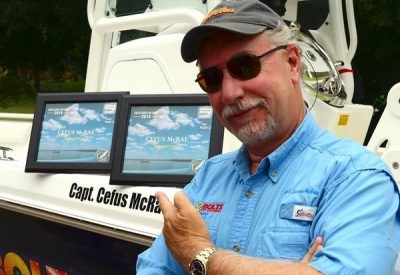By Capt. Cefus McRae
In the real estate world, it’s all about location, location and location. Folks want to put down their roots in an area that is convenient to shopping, grocery stores, good schools, social activities and their workplace. And, they want to live in a climate that suits their particular taste.
When you think about it, the same is true for our piscatorial friends in both fresh and saltwater. Although they may not be pushing a squeaky-wheeled cart down a grocery aisle, they will find a home where there’s ample forage, and their schools teach more about the benefits of “safety-in-numbers” than quantum physics.
Picking the most suitable location to make a homestead is as important to fish as it is to us two-legged critters. If you keep that in mind as you make your selection on where to fish, and in many cases, how to fish, you’ll find your days will become more productive.
With perhaps the exception of the top predators, most fish base their location selection on the Big Three; Food, Comfort and Safety. Identify where all three of those factors converge and you’ve got a very fishy spot.
Game fish have to eat, and they have to eat often, whether it’s a rainbow trout dining on tiny nymphs or billfish that will eat a 25 pound tuna in one bite. A yellowfin tuna has to eat nearly its own weight in food every day, because it spends its entire life roaming the ocean currents, and that uses up a lot of energy. On the other hand, large trout will find a spot in a slip-stream behind a rock waiting for a tasty tidbit to float by. They simply tilt their pectoral fins and the current lifts them up, just like airplane wings to grab a tiny midge and then glide back down to their rock again. That’s not a lot of energy expended for the protein they just gulped. So your first task is to find the kitchen. Sometimes it’s pretty obvious when you see baitfish being corralled on the surface. Sometimes it takes a little more thought and knowledge to locate the dining area. There are seasonal patterns that occur and if you do a little research, or ask around at the local tackle stores, you can get some very valuable information.
The next component is Comfort. Fish will move both horizontally and vertically to find a location that is comfortable. Just like us, they have to breathe. So they will congregate in place in the water column that has the right amount of dissolved oxygen. Ever notice how reservoir-based stripers will move to deeper water in the summertime? Sure, the water is warmer at the surface than it is 50 feet down, but that warm water doesn’t hold as much oxygen as the cooler water does down deep. Fish are cold-blooded, and the actual temperature of the water may have less to do with preferred locations than the oxygen content. Look at how many fish hang around a natural spring upwelling or at a seamount, compared to a placid, sunbaked flat. Remember the old adage about water temperature: “68 and the fishin’s great!” Most of us have experienced the impact weather can have on the fishing, and changes in the barometric pressure, especially quick changes that occur with rapidly moving fronts, can make a dramatic difference in the bite. As the front approaches, the bite can really fire up. When the front arrives, the fish may get lock-jaw for a couple days. I believe the change in pressure (which transfers into the water) can make fish either lethargic or frisky.
And the third piece of the puzzle is Safety. Why isn’t Safety the number one factor? Well if you are starving to death, or can’t breathe, being in a safe place doesn’t really matter, does it? Safety can come in the form of a good hiding place like a rock outcropping, vertical structure such as pilings or ledges, or it can be exhibited by large numbers like we see in schooling baitfish. The ability to blend into the environment or use camouflage is another trait that provides safety from being eaten by something larger. Similarly, predator fish use those same techniques for finding food. Flounder will change their color pattern to match the shelly bottom as they quietly wait on an unsuspecting meal to swim overhead. Speckled trout have unique color patterns on their back that makes them virtually invisible in the grass flats, concealing them from overhead predators like ospreys. And coincidentally, shell banks are great places to fish for flounder, and grass flats are prime locations for catching speckled trout.
Starting to see a pattern?
An inland lake, coastal waters, even a mountain trout stream will usually have places that provide at least two out of the three factors. During certain times of the year, you’ll find a spot that has all three. That would be considered the gold mine. To find these spots, modern technology has provided us anglers with an assortment of tools. Simrad DownScan will show ledges and drop-offs, structure, creek channels, bottom composition, typical spots that hold game fish. Services like Sirius/XM Marine Weather interfaces with your chart plotter to show contemporary weather systems, sea surface temperature, wave period, and wind speed/direction, all of which can be contributing factors to the bite, as well as letting you know when it’s time to head for the barn.
So, do a little homework and check out the real estate below the surface before you make your first cast. Find a location that has the Big Three… Food, Comfort and Safety, and you’ll be well on your way to closing the sale on some fine fishing.
6679 Peachtree Industrial Blvd. Suite D, Peachtree Corners, GA 30092


